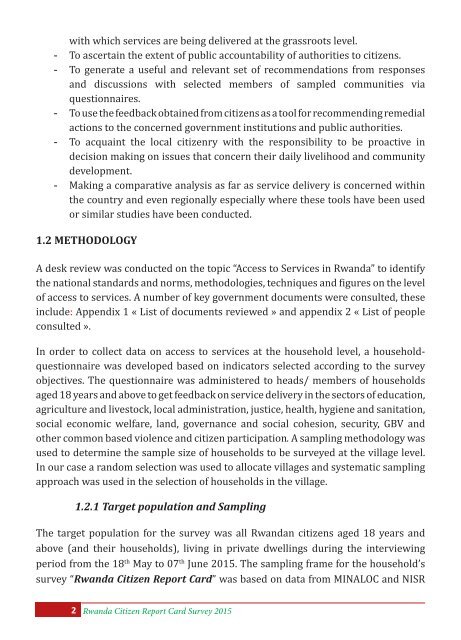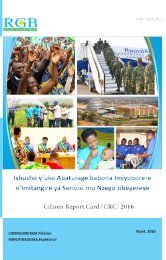CRC 2015. English
Create successful ePaper yourself
Turn your PDF publications into a flip-book with our unique Google optimized e-Paper software.
with which services are being delivered at the grassroots level.<br />
- To ascertain the extent of public accountability of authorities to citizens.<br />
- To generate a useful and relevant set of recommendations from responses<br />
and discussions with selected members of sampled communities via<br />
questionnaires.<br />
- To use the feedback obtained from citizens as a tool for recommending remedial<br />
actions to the concerned government institutions and public authorities.<br />
- To acquaint the local citizenry with the responsibility to be proactive in<br />
decision making on issues that concern their daily livelihood and community<br />
development.<br />
- Making a comparative analysis as far as service delivery is concerned within<br />
the country and even regionally especially where these tools have been used<br />
or similar studies have been conducted.<br />
1.2 METHODOLOGY<br />
A desk review was conducted on the topic “Access to Services in Rwanda” to identify<br />
the national standards and norms, methodologies, techniques and figures on the level<br />
of access to services. A number of key government documents were consulted, these<br />
include: Appendix 1 « List of documents reviewed » and appendix 2 « List of people<br />
consulted ».<br />
In order to collect data on access to services at the household level, a householdquestionnaire<br />
was developed based on indicators selected according to the survey<br />
objectives. The questionnaire was administered to heads/ members of households<br />
aged 18 years and above to get feedback on service delivery in the sectors of education,<br />
agriculture and livestock, local administration, justice, health, hygiene and sanitation,<br />
social economic welfare, land, governance and social cohesion, security, GBV and<br />
other common based violence and citizen participation. A sampling methodology was<br />
used to determine the sample size of households to be surveyed at the village level.<br />
In our case a random selection was used to allocate villages and systematic sampling<br />
approach was used in the selection of households in the village.<br />
1.2.1 Target population and Sampling<br />
The target population for the survey was all Rwandan citizens aged 18 years and<br />
above (and their households), living in private dwellings during the interviewing<br />
period from the 18 th May to 07 th June <strong>2015.</strong> The sampling frame for the household’s<br />
survey “Rwanda Citizen Report Card” was based on data from MINALOC and NISR<br />
2 Rwanda Citizen Report Card Survey 2015




